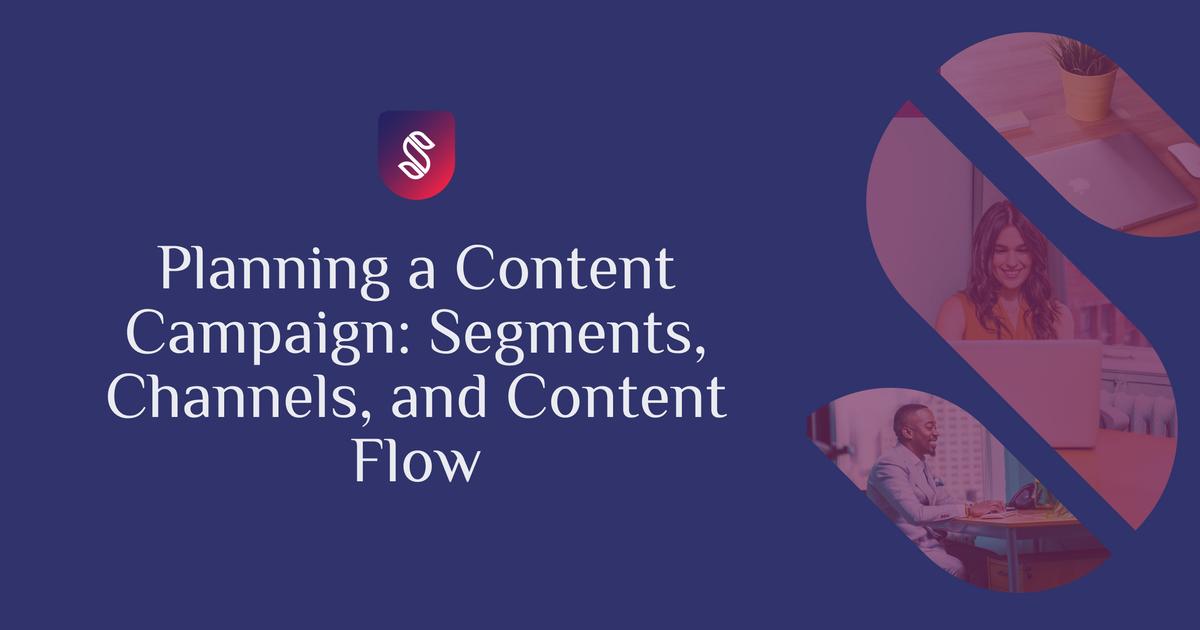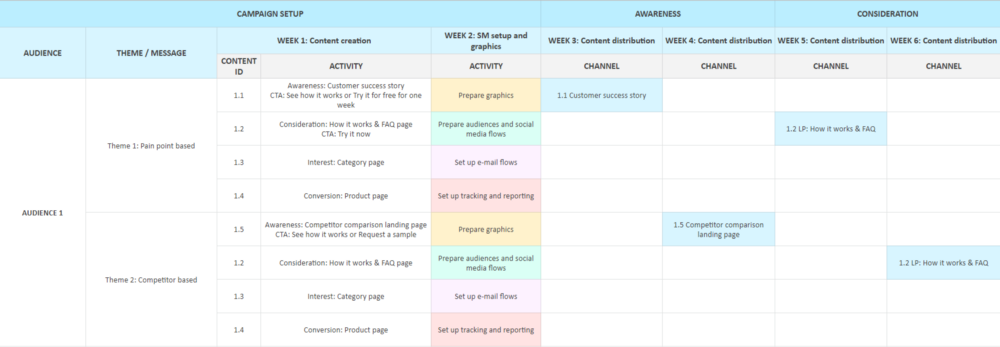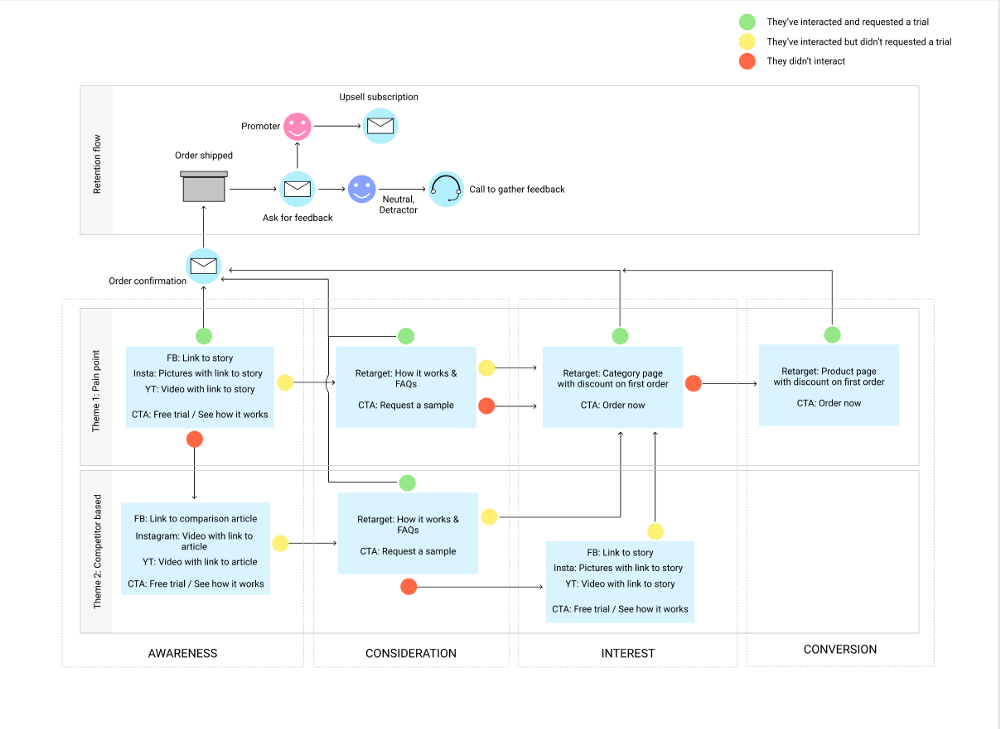Written on 14th August, 2020 | 4 min read
Planning a Content Campaign: Segments, Channels, and Content Flow
A practical example of a content campaign in the food vertical
Andreea Macoveiciuc
Strategist @School of Content

This setup of a content campaign follows the Awareness, Consideration, Interest, Conversion model, so the content types and themes chosen for each step of the funnel will address these specific search intents.
To keep things practical, I’ll use the example of a food & beverage company that sells meal bundles for two different purposes:
weight loss packages
muscle building packages
The campaign’s setup will be as follows:
Campaign length: 12 weeks, of which 2 weeks are reserved for preparing the content.
Each stage of the campaign lasts for 2 weeks, with the last 2 weeks reserved for following up and performing customer interviews.
Channels used: Instagram, YouTube, Facebook, E-mail, Retargeting/Remarketing.
Here’s the overview, you can access the template here.

Image: content campaign setup example
Target audiences and campaign themes
The company sells two different types of bundles, each of them addressing a specific pain point, so our initial segmentation is already done. To keep the messages focused, we’ll create two different audiences:
Audience 1: People trying to lose weight but failing to follow a classical diet
Audience 2: People trying to build muscle mass without putting on fat
These audiences are a bit broad, so we’ll try to narrow down each segment to a more specific one. By doing so, we’ll focus on a single persona inside each segment, whose profile will mimic our ideal customers.
Persona 1 comes from Audience 1, Persona 2 from Audience 2. Here are two potential profiles:
Persona 1: Women between 25–35 years old, trying to lose weight but failing to follow classical diets. They work full time, don’t have the energy or time to prepare healthy meals at home, and practice sports irregularly. They are willing to pay for pre-made meals, as long as they see some proof that the solution works.
Persona 2: Men between 25–40 years old, trying to put on lean mass without gaining fat. They work full time and don’t have time to cook at home, but want to keep their nutrition under control. They’re very careful with their macros, so they will only buy from a trustful brand with positive reviews. They trust friend recommendations.
Obviously, these aren’t all the potential customers from each segment, but they’re the ideal ones because they’re the most likely to buy.
The users who have plenty of time to cook their own meals aren’t our main target, and neither are those who prefer to do all the research by themselves before trying out any new dish.
For each of these audiences, we’ll create a target group for paid ads and e-mails, based on the mentioned pain points. Then, to reach a wider group, we’ll also target a lookalike audience for each segment.
Here is the overview of the target persona 1:

Image: example of target persona with pain points
Content types for each campaign stream
Since we have different target audiences, we’ll go with two campaign streams or themes. We want to keep the messages focused on the user pain points, without combining the topics.
The campaign streams per target audience segment will be the following:
Pain point/value-based stream: the main message is that our solution (the meal bundles) helps them solve their problem
Competitor-based stream: the main message is that our solution is the healthier/more affordable alternative to the main competitor.
So for Persona 1, the solution will address the weight loss struggle, while for Persona 2, the solution will talk about the proper amount of macros for muscle gains. The competitor-based streams will be different for the two audiences.
For each stage of the funnel and channel, we’ll use a variety of content types. I will detail only the streams for one persona, but you can apply the same logic to other segments.
Content types for Stream 1, Persona 1:
Awareness: Success story that shows how the solution helped someone else solve the pain point. There are two CTAs:
See how it works, which directs the user to the Consideration phase,
Try it for free for one week, which directs the user to the Interest phase.
Consideration: Landing page explaining how the solution works, with FAQs included. It should address the barriers and highlight the benefits, mapping them to the reasons to buy.
Interest: Category page displaying the three bundles the user can choose from.
Conversion: Product pages for each bundle.
If the user doesn’t interact with the social media posts in the first two phases, the third and fourth phases will offer a discount for the first order. The “Try for free” CTA is therefore no longer applied to this user.
Similarly, the second stream or theme will have in the Awareness phase a comparison article that highlights the benefits of our solution compared to the main competitors.
Distribution flow
To make things easier to scale, we’ll automate as many of the tasks as possible, when it comes to distributing the content. Here’s how the automation flow could look like:

Image: example of distribution flow
We’ll use paid ads on Facebook and YouTube, and promoted posts on Instagram. The order confirmation e-mail and the NPS messages for collecting feedback will be sent via the marketing automation tool.
The only direct interaction of the customer service team with the user will be the call for gathering feedback, which will only apply to neutral users and detractors.
I hope this gives you a clear overview and helps you in planning your next content campaign!
If you need help in creating a content campaign, get in touch with our team. We'll research your ideal customers and create a campaign proposal based on your goals.